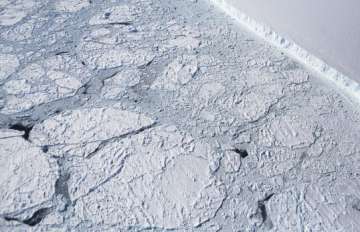In shocking news, a large iceberg that is twice the size of New York City will soon break off Antarctica, warns NASA scientists. Researchers are worried about how that will impact the remaining ice shelf, where scientists are currently stationed. The rifts may destabilize the entire shelf.
The scientists’ base of operations has been rebuilt and relocated over the years, and it’s had to be closed down twice in recent years because of changes in the ice, NASA said.
Satellite images show large cracks across Antartica’s Brunt Ice Shelf that could lead to a 660-square-mile iceberg calved, or broken off, from the shelf, according to a NASA news release.
Ice breaking off from shelves is called calving.9. Though it’s a normal part of their life cycles, calving has been seen at an increasing rate in recent years.
While NASA said this wouldn’t be a “terribly large iceberg by Antartica standards,” it may be the largest iceberg to calve from the Brunt Ice Shelf since observations began in 1915.
NASA scientists said the first crack in the ice shelf appeared in late October 2016. Since then, the crack, also known as the “Halloween crack,” continues to grow eastward toward an area known as the McDonald Ice Rumples.
However, the space agency said its more immediate concern is the rift visible on the Brunt Ice Shelf, seen in the center of the above image take on Jan. 23.
“Previously stable for about 35 years, this crack recently started accelerating northward as fast as 4 kilometers per year,” NASA said in a news release.
Scientists said it’s not yet clear how the remaining ice shelf will respond following the break, posing an uncertain future for scientific infrastructure and human presence on the shelf. The space agency is now watching to see if the loss will trigger the shelf to further change, and possibly become unstable or break up.
In the two years since, Chasm 1 has crept closer to the Halloween crack, preparing scientists for the inevitability of a iceberg breakaway that could have greater consequences for the stability of the entire Brunt Ice Shelf. NASA predicts the mass could span 1,700 square kilometers (660 square miles), which would make it the largest iceberg to break from the Brunt Ice Shelf in more than 100 years.
"It's a large berg, but it's not a massive berg - not by Antarctic standards," said Christopher Shuman, a research scientist at the University of Maryland Baltimore County's Joint Center for Earth Systems Technology at NASA. "The impact on the area is that these rifts have reactivated, and we're not sure why. A new rift (Halloween crack) formed it what was thought to be a pretty stable ice shelf."
Scientists have only been studying glacier shelves for a little over 100 years, so it's difficult to say whether icebergs are calving at a higher rate at this location on the Brunt Ice Shelf, said Helen Fricker, a glaciologist at the Scripps Institution of Oceanography.
"I don't think you can link one calving event to climate change," Fricker said. "That isn't to say Antarctica isn't undergoing rapid changes that are linked to climate change. But it's in another region of Antarctica."
(With Inputs from The Washington Post)
